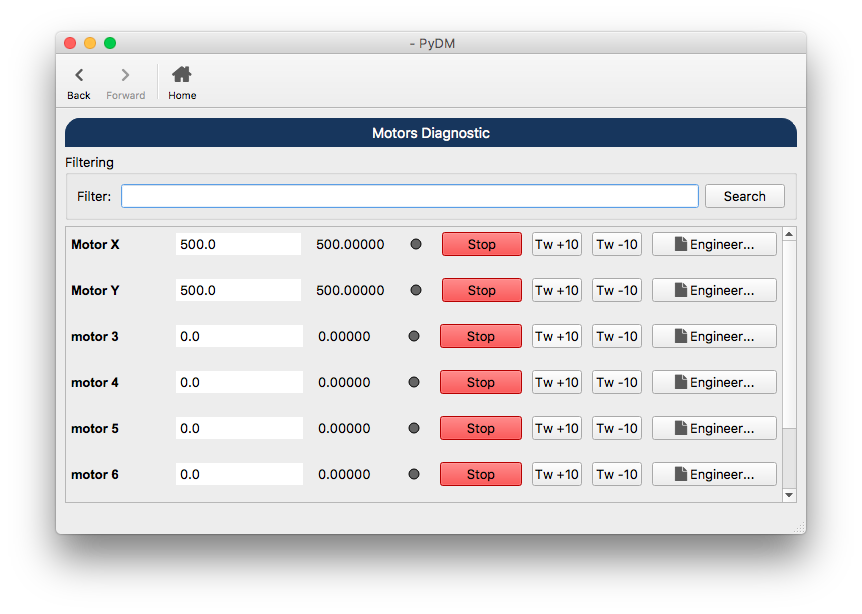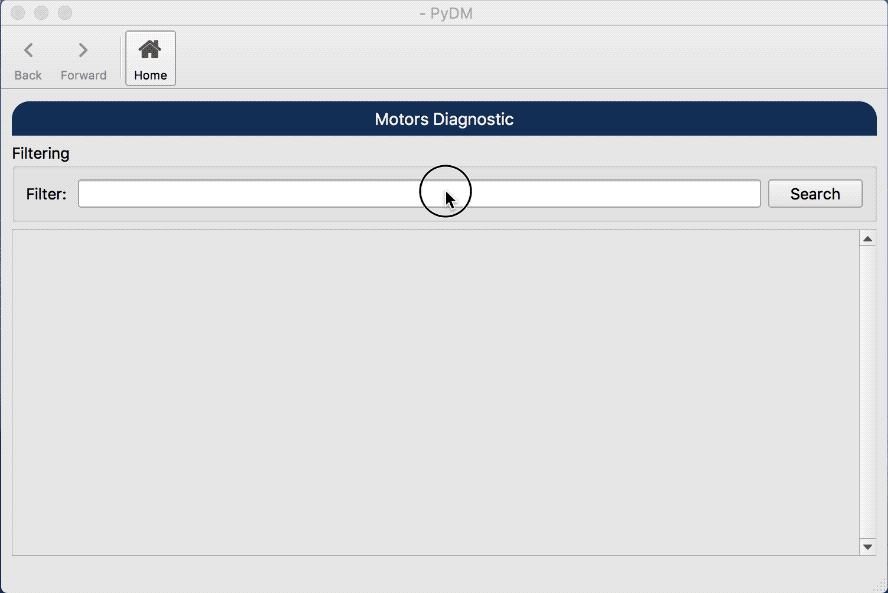Making Pure Python Displays
Important
Make sure the PCASpy tutorial server is running
As we saw in the A Word About Python Display section, it is possible to make displays using Python code and a .ui file from Qt Designer. It is also possible to make displays without using the Qt Designer at all, and write the user interface entirely in code.
To demonstrate this capability we will describe the steps to create the “All Motors” screen described at the Components Section.
This screen will have a QLineEdit and a QPushButton that will invoke a
method to filter our list of motors and present a list of
PyDMEmbeddedDisplays in the frame below pointing to the
inline_motor.ui file that was created in the
Inline Motor Screen section of this tutorial.
Here is how it will look once we are done:

Important
In order to simplify this tutorial, instead of using a database or other type
of service, the data to populate the list of motors will come from a simple text file
named motor_db.txt that can be downloaded here.
Step 1.
The first thing that we will do is add the imports needed for the code that will follow.
import os import json from qtpy import QtCore from pydm import Display from qtpy.QtWidgets import (QVBoxLayout, QHBoxLayout, QGroupBox, QLabel, QLineEdit, QPushButton, QScrollArea, QFrame, QApplication, QWidget) from pydm.widgets import PyDMEmbeddedDisplay from pydm.utilities import connection
Step 2.
Let’s create our Python Class that will inherit from
Display(See Subclassing Display).class AllMotorsDisplay(Display): def __init__(self, parent=None, args=[], macros=None): super().__init__(parent=parent, args=args, macros=None) # Placeholder for data to filter self.data = [] # Reference to the PyDMApplication self.app = QApplication.instance() # Load data from file self.load_data() # Assemble the Widgets self.setup_ui() def minimumSizeHint(self): # This is the default recommended size # for this screen return QtCore.QSize(750, 120) def ui_filepath(self): # No UI file is being used return None
Breaking it down into pieces:
The constructor of the class will call the
load_datamethod that is responsible for opening our database and adding the information to our placeholder,self.data, for later filtering, as well as thesetup_uimethod in which the widgets be constructed and configured.minimumSizeHintreturns the suggested minimum dimensions for the display.ui_filepathwill returnNone, as nouifile is being used in this case.
Step 2.1.
Add the code to the
load_datamethod.Note
Look at the comments over the lines for explanation on what they do.
def load_data(self): # Extract the directory of this file... base_dir = os.path.dirname(os.path.realpath(__file__)) # Concatenate the directory with the file name... data_file = os.path.join(base_dir, "motor_db.txt") # Open the file so we can read the data... with open(data_file, 'r') as f: # For each line in the file... for entry in f.readlines(): # Append to the list of data... self.data.append(entry[:-1])
Step 2.2.
Add the code to the
setup_uimethod.Note
Look at the comments over the lines for explanation on what they do.
def setup_ui(self): # Create the main layout main_layout = QVBoxLayout() self.setLayout(main_layout) # Create a Label to be the title lbl_title = QLabel("Motors Diagnostic") # Add some StyleSheet to it lbl_title.setStyleSheet("\ QLabel {\ qproperty-alignment: AlignCenter;\ border: 1px solid #FF17365D;\ border-top-left-radius: 15px;\ border-top-right-radius: 15px;\ background-color: #FF17365D;\ padding: 5px 0px;\ color: rgb(255, 255, 255);\ max-height: 25px;\ font-size: 14px;\ }") # Add the title label to the main layout main_layout.addWidget(lbl_title) # Create the Search Panel layout search_layout = QHBoxLayout() # Create a GroupBox with "Filtering" as Title gb_search = QGroupBox(parent=self) gb_search.setTitle("Filtering") gb_search.setLayout(search_layout) # Create a label, line edit and button for filtering lbl_search = QLabel(text="Filter: ") self.txt_filter = QLineEdit() self.txt_filter.returnPressed.connect(self.do_search) btn_search = QPushButton() btn_search.setText("Search") btn_search.clicked.connect(self.do_search) # Add the created widgets to the layout search_layout.addWidget(lbl_search) search_layout.addWidget(self.txt_filter) search_layout.addWidget(btn_search) # Add the Groupbox to the main layout main_layout.addWidget(gb_search) # Create the Results Layout self.results_layout = QVBoxLayout() self.results_layout.setContentsMargins(0, 0, 0, 0) # Create a Frame to host the results of search self.frm_result = QFrame(parent=self) self.frm_result.setLayout(self.results_layout) # Create a ScrollArea so we can properly handle # many entries scroll_area = QScrollArea(parent=self) scroll_area.setVerticalScrollBarPolicy(QtCore.Qt.ScrollBarAlwaysOn) scroll_area.setHorizontalScrollBarPolicy(QtCore.Qt.ScrollBarAlwaysOff) scroll_area.setWidgetResizable(True) # Add the Frame to the scroll area scroll_area.setWidget(self.frm_result) # Add the scroll area to the main layout main_layout.addWidget(scroll_area)
Step 2.3.
Add the code to connect the
QPushButtonclick and perform the search on our data.Note
Look at the comments over the lines for explanation on what they do.
def do_search(self): # For each widget inside the results frame, lets destroy them for widget in self.frm_result.findChildren(QWidget): widget.setParent(None) widget.deleteLater() # Grab the filter text filter_text = self.txt_filter.text() # For every entry in the dataset... for entry in self.data: # Check if they match our filter if filter_text.upper() not in entry.upper(): continue # Create a PyDMEmbeddedDisplay for this entry disp = PyDMEmbeddedDisplay(parent=self) disp.macros = json.dumps({"MOTOR":entry}) disp.filename = 'inline_motor.ui' disp.setMinimumWidth(700) disp.setMinimumHeight(40) disp.setMaximumHeight(100) # Add the Embedded Display to the Results Layout self.results_layout.addWidget(disp)
Important
Since PyDM v1.6.0 it is no longer required to call
pydm.utilities.connection.establish_widget_connectionsandpydm.utilities.connection.close_widget_connections.
Step 3.
Save this file as
all_motors.py.Warning
For this tutorial it is important to use this file name as it will be referenced at the other sections. If you change it please remember to also change at the other steps when referenced.
Step 4.
Test the All Motors Screen:
pydm all_motors.py
Note
You can download this file using this link.